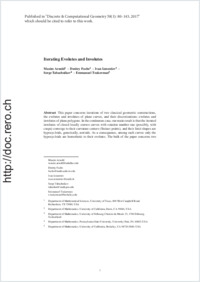Iterating evolutes and involutes
- Arnold, Maxim Department of Mathematical Sciences, University of Texas, Richardson, USA
- Fuchs, Dmitry Department of Mathematics, University of California, Davis, USA
- Izmestiev, Ivan Department of Mathematics, University of Fribourg, Switzerland
- Tabachnikov, Serge Department of Mathematics, Pennsylvania State University, USA
- Tsukerman, Emmanuel Department of Mathematics, University of California, Berkeley, USA
-
01.07.2017
Published in:
- Discrete & Computational Geometry. - 2017, vol. 58, no. 1, p. 80–143
Evolute
Involute
Hypocycloid
Steiner point
Hedgehog
Support function
4-Vertex theorem
Polygon
Discrete Fourier transform
Discrete differential geometry
English
This paper concerns iterations of two classical geometric constructions, the evolutes and involutes of plane curves, and their discretizations: evolutes and involutes of plane polygons. In the continuous case, our main result is that the iterated involutes of closed locally convex curves with rotation number one (possibly, with cusps) converge to their curvature centers (Steiner points), and their limit shapes are hypocycloids, generically, astroids. As a consequence, among such curves only the hypocycloids are homothetic to their evolutes. The bulk of the paper concerns two kinds of discretizations of these constructions: the curves are replaced by polygons, and the evolutes are formed by the circumcenters of the triples of consecutive vertices ( PP - evolutes), or by the incenters of the triples of consecutive sides ( AA -evolutes). For equiangular polygons, the theory is parallel to the continuous case: we define discrete hypocycloids (equiangular polygons whose sides are tangent to hypocycloids) and a discrete Steiner point. The space of polygons is a vector bundle over the space of the side directions; our main result here is that both kinds of evolutes define vector bundle morphisms. In the case of PP -evolutes, the induced map of the base is 4-periodic, and the dynamics reduces to the linear maps on the fibers. We prove that the spectra of these linear maps are symmetric with respect to the origin. The asymptotic dynamics of linear maps is determined by their eigenvalues with the maximum modulus, and we show that all types of behavior can occur: in particular, hyperbolic, when this eigenvalue is real, and elliptic, when it is complex. We also study PP - and AA -involutes and prove that the side directions of iterated AA -involutes of polygons with odd number of sides behave ergodically; this generalizes well-known results concerning iterations of the construction of the pedal triangle. In addition to the theoretical study, we performed numerous computer experiments; some of the observations remain unexplained.
- Faculty
- Faculté des sciences et de médecine
- Department
- Département de Mathématiques
- Language
-
- English
- Classification
- Mathematics
- License
- License undefined
- Identifiers
-
- RERO DOC 305086
- DOI 10.1007/s00454-017-9890-y
- Persistent URL
- https://folia.unifr.ch/unifr/documents/306126
Statistics
Document views: 69
File downloads:
- izm_iei.pdf: 270
